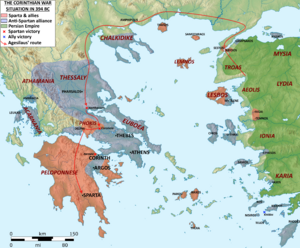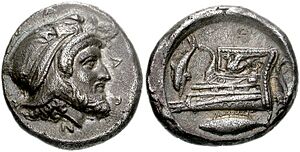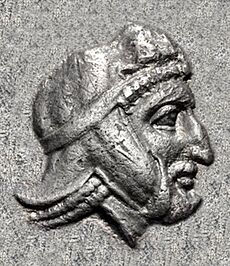Corinthian War facts for kids
Quick facts for kids Corinthian War |
|||||||||
|---|---|---|---|---|---|---|---|---|---|
| Part of the Spartan hegemony | |||||||||
|
|||||||||
| Belligerents | |||||||||
|
|||||||||
| Commanders and leaders | |||||||||
|
|
||||||||
The Corinthian War (395–387 BC) was a big fight in ancient Greece. It was between Sparta and a group of other powerful city-states. These included Thebes, Athens, Corinth, and Argos. The mighty Achaemenid Empire (Persia) also helped the group against Sparta.
The war started because many cities were unhappy with Sparta. After the Peloponnesian War, Sparta had become very powerful. But they didn't share the rewards fairly with their old friends like Corinth and Thebes. Also, Athens, who lost the last war, wanted to get strong again.
In 395 BC, while the Spartan king Agesilaus II was fighting in Asia, Thebes, Athens, Corinth, and Argos formed an alliance. They wanted to stop Sparta from controlling all of Greece. Their main meeting place was in Corinth, which is how the war got its name. Even though the allies didn't fully stop Sparta's power, the war made Sparta much weaker in the long run.
At first, Sparta won some big battles on land, like at Nemea and Coronea. But they lost their advantage at sea. Their entire fleet was destroyed by the Persian fleet in the naval Battle of Cnidus. This ended Sparta's dream of being a strong naval power. After this, Athens started winning back islands they used to control. This worried the Persians, so they switched sides and started helping Sparta. This change forced the allies to seek peace.
The war ended with a treaty called the King's Peace, also known as the Peace of Antalcidas. The Persian King Artaxerxes II made the rules for this peace in 387 BC. The treaty said that Persia would control all the Greek cities in Asia. All other Greek cities would be "autonomous," meaning they couldn't form alliances or groups. Sparta was chosen to make sure everyone followed these rules. This war showed that Persia could now easily get involved in Greek politics. It also kept Greek city-states separate and confirmed Sparta's power for a while. Thebes lost a lot, as their league was broken up, and Spartan soldiers were placed in their cities. But this peace didn't last long. Another war between Sparta and Thebes started in 378 BC. This eventually led to Sparta losing its power completely at the Battle of Leuctra in 371 BC.
Contents
Why the War Started
After the Peloponnesian War ended in 404 BC, Sparta was very strong. Almost all Greek states on the mainland and the Persian Empire had helped Sparta win. Many islands in the Aegean Sea also came under Sparta's control. However, this strong support soon fell apart.
Sparta took all the treasures and money from the defeated cities. They did not share them with their allies, even though everyone had helped win the war. Sparta's allies became even more upset when Sparta attacked Elis in 402 BC. Elis was a member of Sparta's own league. Corinth and Thebes refused to send soldiers to help Sparta in this fight.

Thebes, Corinth, and Athens also refused to join a Spartan trip to Ionia in 398 BC. The Thebans even stopped King Agesilaus from performing a religious ceremony in their land before he left. Even without these states, Agesilaus fought well against the Persians in Lydia. He went deep into Persian land. The Persian governor Tissaphernes was even executed for failing to stop Agesilaus. His replacement, Tithraustes, paid the Spartans to move north.
The Persian governor Pharnabazus II could not defeat Agesilaus's army. So, he decided to make trouble for Sparta back in Greece. He sent Timocrates of Rhodes with ten thousand gold coins called Darics. Timocrates was told to give these coins to the main cities in Greece. He visited Athens, Thebes, Corinth, and Argos. He successfully convinced important groups in each city to oppose Sparta. It is said that King Agesilaus joked he was "driven out by 10,000 Persian archers." This was a funny way to talk about the Daric coins, which had archers on them. These coins were used to pay politicians in Athens and Thebes to start a war against Sparta. The Thebans, who already disliked Sparta, agreed to start the war.
First Fights (395 BC)
Battle of Haliartus
The historian Xenophon says that Thebes did not want to fight Sparta directly. Instead, they encouraged their friends, the Locrians, to collect taxes from land also claimed by Phocis. The Phocians then invaded Locris. The Locrians asked Thebes for help, and Thebes invaded Phocian land. The Phocians then asked their ally, Sparta, for help. Sparta was happy to have a reason to punish Thebes and prepared their army.
Thebans sent messengers to Athens to ask for support. The Athenians voted to help Thebes. They formed a lasting alliance between Athens and the Boeotian confederacy. Sparta planned for two armies to meet and attack the city of Haliartus in Boeotia. One army was led by Lysander and the other by Pausanias. Lysander arrived first and convinced Orchomenus to leave the Boeotian group. He then moved to Haliartus. Lysander was killed in the Battle of Haliartus after getting too close to the city walls. The battle was not a clear win for either side. Sparta lost some men early on but then defeated some Thebans. Pausanias arrived a day later. He took back the bodies of the Spartan dead under a truce. He then returned to Sparta. There, he was put on trial for not arriving on time to help Lysander. He ran away before he could be found guilty.
More Cities Join the Alliance
After these events, both Sparta and its enemies got ready for more serious fighting. In late 395 BC, Corinth and Argos joined Athens and Thebes in the war. They formed a council in Corinth to manage their alliance. The allies then sent messengers to many smaller states. Many of these states decided to support the alliance. Some of the cities that joined were East Lokris, Thessaly, Leukas, Acarnania, Ambracia, Chalcidian Thrace, Euboea, Athamania, and Ainis. Meanwhile, the Boeotians and Argives captured Heraclea Trachinia. Only Phokis and Orchomenos stayed loyal to Sparta in Central Greece.
Sparta was worried by these changes. They prepared to send an army against this new alliance. They sent a messenger to Agesilaus, telling him to come back to Greece. Agesilaus was disappointed because he wanted to keep fighting in Asia. He joked that 10,000 Persian "archers" (referring to the coins) had driven him out of Asia. So, he turned back with his troops. He crossed the Hellespont and marched west through Thrace.
War on Land and Sea (394 BC)
Battle of Nemea
After a small fight between Thebes and Phocis, where Thebes won, the allies gathered a large army at Corinth. Sparta sent a big army to fight them. The armies met at the dry bed of the Nemea River, near Corinth. The Spartans won a major victory. In these types of battles, the right side of each army usually won. The Spartans defeated the Athenians. Meanwhile, the Thebans, Argives, and Corinthians defeated the Peloponnesians on their side. The Spartans then attacked and killed many Argives, Corinthians, and Thebans as they returned from chasing the defeated Peloponnesians. The allied army lost 2,800 men. Sparta and its allies lost only 1,100.
Battle of Cnidus
The next big battle was at sea. Both the Persians and Spartans had built large fleets during Agesilaus's time in Asia. Agesilaus had gathered 120 triremes (warships) from the Aegean states he controlled. He put his brother-in-law Peisander in charge, even though Peisander had never led a fleet before. The Persians had a fleet from Phoenicia, Cilicia, and Cyprus. This fleet was led by the Persian governor Pharnabazus II and the skilled Athenian admiral Conon. Conon was living in exile and working for the Persians. This Persian fleet had already taken Rhodes from Spartan control in 396 BC.
These two fleets met near Cnidus in 394 BC. The Spartans fought bravely, especially around Peisander's ship. But they were eventually defeated. Many Spartan ships were sunk or captured. Their fleet was almost completely destroyed. After this victory, Conon and Pharnabazus sailed along the coast of Ionia. They removed Spartan governors and soldiers from cities like Kos, Nisyros, Telos, Chios, Mytilene, Ephesos, and Erythrae. However, they could not capture the Spartan bases at Abydos and Sestos.
Battle of Coronea
By this time, Agesilaus's army had arrived in Boeotia. They had fought off attacks from the Thessalians on their march. An army from the anti-Spartan alliance met them there. Agesilaus's army from Asia included freed slaves and experienced mercenaries. He also had Spartan soldiers from Orchomenus and others brought across the Gulf of Corinth. These armies met at Coronea, in Theban land. Like at Nemea, both right sides won. The Thebans broke through, while the rest of the allies were defeated.
Seeing that their friends were beaten, the Thebans tried to fight their way back to their camp. Agesilaus met them head-on. Many Thebans were killed in the struggle. But the rest managed to force their way through and rejoin their allies. After this victory, Agesilaus sailed his army across the Gulf of Corinth and returned to Sparta.
Later Years (393–388 BC)
After the battles of 394 BC, Sparta was strong on land but weak at sea. The allied cities could not defeat the Spartan army in open battle. But they kept their alliance strong. This stopped Sparta from moving freely through central Greece. Sparta kept trying to get Corinth or Argos to leave the war. The anti-Spartan allies worked to stay united. Athens and Thebes used Sparta's busy schedule to increase their own power.
Persian Help for Athens (393 BC)
After his victory at Cnidus, Pharnabazus captured several Spartan-allied cities in Ionia. He encouraged people to support Athens and democracy. Only Abydus and Sestus refused to kick out the Spartans. Pharnabazus tried to force them by destroying their lands, but it didn't work. So, he left Conon in charge of winning over the cities in the Hellespont.
In 393 BC, Pharnabazus II and Conon sailed their fleet to the island of Melos. They set up a base there. This was the first time in 90 years that the Persian fleet had come so far west. This led to democratic changes and new alliances with Athens on the islands.
The fleet then sailed further west to get revenge on the Spartans. They invaded Spartan land, destroying Pherae and raiding the coast of Messenia. They probably wanted to cause a revolt of the Messenian slaves against Sparta. They eventually left because they ran out of supplies and there were few safe harbors for their fleet. Also, Spartan relief forces might have arrived.
They then raided the coast of Laconia and captured the island of Cythera. They left soldiers and an Athenian governor there. This was meant to hurt Sparta's ability to attack. Cythera became Persian territory. Taking Cythera also cut off the important sea route between Peloponnesia and Egypt. This stopped Sparta and Egypt from working together. It also directly threatened Taenarum, Sparta's harbor.
Pharnabazus II left part of his fleet in Cythera. He then went to Corinth. There, he gave money to Sparta's enemies to further threaten the Spartans. He also paid for Corinth to rebuild its fleet to fight Sparta.
Rebuilding Athens' Walls
Conon convinced Pharnabazus that rebuilding the Long Walls around Piraeus, Athens' main port, would be a big blow to Sparta. Pharnabazus eagerly gave Conon a fleet of 80 triremes and more money for this task. Conon went to Attica and helped rebuild the long walls connecting Athens to Piraeus. This project had started in 394 BC. With the help of the fleet's rowers and workers paid by Persian money, the walls were soon finished.
Athens quickly used its new walls and fleet. They captured the islands of Scyros, Imbros, and Lemnos. They set up citizen colonies there. As a reward for his success, Pharnabazus was allowed to marry the king's daughter. He was called back to Persia in 393 BC. A new governor, Tiribazus, took his place.
Trouble in Corinth
Around this time, civil unrest broke out in Corinth. There were two groups: the democratic party and the oligarchic party. The democrats, supported by the Argives, attacked their opponents. The oligarchs were forced to leave the city. These exiles went to the Spartans, who were based at Sicyon, for help. Meanwhile, the Athenians and Boeotians came to support the democrats.
In a night attack, the Spartans and exiles captured Lechaeum, Corinth's port on the Gulf of Corinth. They defeated the army that came out to fight them the next day. The anti-Spartan allies then tried to surround Lechaeum. But the Spartans attacked and drove them away.
Peace Talks Fail
In 392 BC, Sparta sent an ambassador named Antalcidas to the Persian governor Tiribazus. Sparta hoped to turn the Persians against the allies. They told the Persians that Conon was using the Persian fleet to rebuild the Athenian empire. The Athenians found out and sent Conon and others to present their side to the Persians. They also told their allies, and Argos, Corinth, and Thebes sent their own messengers to Tiribazus.
At the meeting, Sparta suggested a peace where all states would be independent. The allies rejected this. Athens wanted to keep the islands it had gained. Thebes wanted to keep control over its Boeotian league. Argos wanted to join with Corinth. So, the meeting failed. However, Tiribazus was worried by Conon's actions. He arrested Conon and secretly gave Sparta money to build a fleet. Conon soon escaped but died shortly after.
Another peace meeting was held in Sparta that same year. But the allies again rejected the proposals. They disliked the idea of all states being independent. The Athenians were also angry that the terms would mean giving up the Ionian Greeks to Persia.
After the failed meeting in Persia, Tiribazus went back to Persia to report. A new general, Struthas, was sent to take command. Struthas was against Sparta. This made the Spartans order their commander, Thibron, to attack him. Thibron successfully raided Persian land for a while. But he was killed along with many of his soldiers when Struthas ambushed one of his poorly organized raiding trips. Thibron was later replaced by Diphridas. Diphridas had more success raiding and even captured Struthas's son-in-law. But he never achieved any big victories.
Lechaeum and Corinth
In Corinth, the democratic group still held the city. But the exiles and their Spartan friends held Lechaeum. From there, they raided the Corinthian countryside. In 391 BC, Agesilaus fought in the area. He successfully captured several strong points. He also took many prisoners and much loot. While Agesilaus was preparing to sell his spoils, the Athenian general Iphicrates won a big victory. He had light troops and peltasts (javelin throwers). He defeated the Spartan soldiers stationed at Lechaeum in the Battle of Lechaeum.
During the battle, Iphicrates used the Spartans' lack of peltasts to his advantage. He kept attacking the Spartan soldiers quickly and then running away. This wore the Spartans down until they broke and ran. Many of them were killed. Agesilaus went home soon after this. But Iphicrates continued to fight around Corinth. He recaptured many of the strong points Sparta had taken. However, he could not retake Lechaeum. He also fought against Phlius and Arcadia. He decisively defeated the Phliasians and plundered the Arcadians' land when they refused to fight his troops.
After this victory, an Argive army came to Corinth. They captured the acropolis (a fortified part of the city). This led to Argos and Corinth joining together. The border markers between Argos and Corinth were torn down. The citizens of both cities became one.
Later Land Fights

After Iphicrates's victories near Corinth, there were no more big land battles in that area. Fighting continued in the Peloponnese and the northwest. Agesilaus had fought well in Argive land in 391 BC. He led two more big trips before the war ended. In the first, in 389 BC, a Spartan army crossed the Gulf of Corinth. They attacked Acarnania, an ally of the anti-Spartan group. At first, it was hard to fight the Acarnanians, who stayed in the mountains. But Agesilaus eventually got them into a big battle. The Acarnanians were defeated and lost many men. He then sailed home. The next year, the Acarnanians made peace with the Spartans to avoid more invasions.
In 388 BC, Agesipolis led a Spartan army against Argos. No Argive army challenged him. So, he looted the countryside for a while. Then, after getting some bad omens, he returned home.
Later Fights in the Aegean Sea
After their defeat at Cnidus, the Spartans started to rebuild a fleet. In fights with Corinth, they had regained control of the Gulf of Corinth by 392 BC. After the peace talks failed in 392 BC, Sparta sent a small fleet. It was led by Ecdicus. He was ordered to help the rich leaders exiled from Rhodes. Ecdicus arrived at Rhodes to find the democratic group fully in control. They had more ships than him. So, he waited at Cnidus. Sparta then sent their fleet from the Gulf of Corinth, led by Teleutias, to help. After picking up more ships at Samos, Teleutias took command at Cnidus and started operations against Rhodes.

Athens was worried by Sparta's return to naval power. They sent out a fleet of 40 triremes led by Thrasybulus. He decided he could do more by fighting where the Spartan fleet was not. So, he sailed to the Hellespont. There, he convinced several major states to join Athens. He also placed a tax on ships sailing past Byzantium. This brought back money that Athens had relied on. He then sailed to Lesbos. With help from the Mytileneans, he defeated the Spartan forces on the island. He won over many cities. However, while still on Lesbos, Thrasybulus was killed by raiders from the city of Aspendus.
After this, Sparta sent a new commander, Anaxibius, to Abydos. For a time, he had many successes against Pharnabazus. He captured many Athenian merchant ships. Athens was worried that Thrasybulus's achievements were being undone. So, they sent Iphicrates to the region to fight Anaxibius. For a while, the two forces just raided each other's land. But eventually, Iphicrates guessed where Anaxibius would bring his troops on a return march. He ambushed the Spartan force. Anaxibius and his men were spread out in a line. They entered rough, mountainous land where Iphicrates and his men were waiting. The Athenians attacked them, killing Anaxibius and many others.
Aegina and Piraeus
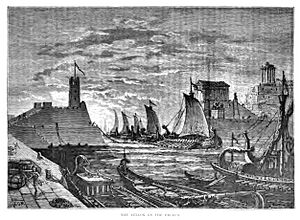
In 389 BC, the Athenians attacked the island of Aegina. It was off the coast of Attica. The Spartans soon drove off the Athenian fleet. But the Athenians continued their land attack. Under Antalcidas' command, the Spartan fleet sailed east to Rhodes. But it was eventually blocked at Abydos by the Athenian commanders in the region. The Athenians on Aegina soon found themselves under attack. They left after several months.
Soon after, the Spartan fleet led by Gorgopas ambushed the Athenian fleet near Athens. They captured several ships. The Athenians responded with their own ambush. Chabrias, on his way to Cyprus, landed his troops on Aegina. He set an ambush for the Aeginetans and their Spartan allies. He killed many of them, including Gorgopas.
The Spartans then sent Teleutias to Aegina to command the fleet there. He noticed that the Athenians had become less careful after Chabrias's victory. He launched a raid on Piraeus, capturing many merchant ships.
The King's Peace (387 BC)

Meanwhile, Antalcidas had been talking with Tiribazus. They made a deal. Persia would join the war on Sparta's side if the allies refused to make peace. It seems the Persians were worried by some of Athens' actions. Athens had supported King Evagoras of Cyprus and Akoris of Egypt. Both were fighting Persia. So, Persia decided that helping Sparta's enemies was no longer useful. After escaping the blockade at Abydos, Antalcidas attacked and defeated a small Athenian force. Then he joined his fleet with another fleet sent from Syracuse. With this force, which soon got more ships from local governors, he sailed to the Hellespont. There, he could cut off the trade routes that brought grain to Athens. The Athenians remembered their similar defeat in the Peloponnesian War. They were ready to make peace.
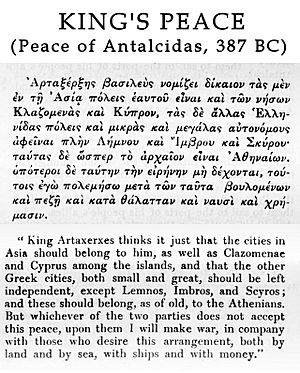
In this situation, Tiribazus called a peace meeting in late 387 BC. The main groups in the war were ready to talk terms. The basic plan for the treaty was set by a decree from the Persian king Artaxerxes:
King Artaxerxes thinks it is fair that the cities in Asia should belong to him. Also, Clazomenae and Cyprus among the islands. And that the other Greek cities, both small and large, should be left autonomous (αὐτονόμους). Except for Lemnos, Imbros, and Scyros; these should belong, as before, to the Athenians. But if either side does not accept this peace, I will make war on them. I will do this with those who want this agreement, both by land and by sea, with ships and with money.
According to this peace treaty:
- All of Asia Minor, with the islands of Clazomenae and Cyprus, was recognized as belonging to Persia.
- All the Greek city states were to be "autonomous." This meant they could not form leagues or alliances. The only exceptions were Lemnos, Imbros, and Scyros, which were given back to the Athenians.
At a general peace meeting in Sparta, the Spartans had more power because of the threat of Persian help. They got all the major Greek states to agree to these terms. The city governments approved the terms over the next year. This re-establishment of Spartan power over Greece, by giving up the Greeks in Asia Minor to Persia, has been called the "most shameful event in Greek history."
The agreement was known as the King's Peace. This showed how much influence Persia had on the treaty. This treaty put Greece under Persian control. It was the first attempt at a Common Peace in Greek history. Under the treaty, all cities were to be independent. Sparta would make sure this rule was followed. Thebes had to break up its league. Argos and Corinth ended their shared government. Corinth, without its strong ally, rejoined Sparta's Peloponnesian League. After 8 years of fighting, the Corinthian War was over.
What Happened Next
In the years after the peace treaty, Persia and Sparta both benefited greatly. Persia no longer had Athens or Sparta bothering its provinces in Asia. It strengthened its control over the eastern Aegean Sea. By 380 BC, Persia even captured Egypt and Cyprus. Meanwhile, Sparta used its new official position as the leader of Greece. It used the "autonomy" rule of the peace to break up any group it saw as a threat. Disloyal allies were punished severely. For example, Mantinea was broken up into five smaller villages. With Agesilaus leading the state and pushing for aggressive actions, the Spartans fought from the Peloponnese to the far-off Chalcidic peninsula. Their control over mainland Greece would last another sixteen years. Then, it was shattered at Leuctra.
The war also marked the start of Athens becoming powerful again in the Greek world. With their walls and fleet rebuilt, the Athenians could look overseas. By the mid-4th century, they had formed a group of Aegean states. This was known as the Second Athenian League. They got back at least some of what they had lost in 404 BC.
The freedom of the Ionian Greeks had been a popular idea since the early 5th century. But after the Corinthian War, the mainland Greek states stopped trying to interfere with Persia's control of the region. After more than a century of trouble, Persia finally ruled western Anatolia without interruption for over 50 years. This lasted until the time of Alexander the Great.


